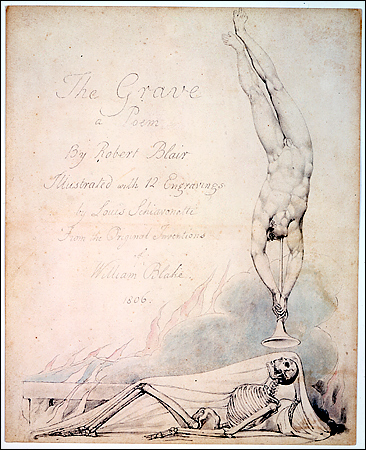First posted August 2011.
One of the most deflating episodes of Blake's life involved the publication of Robert Blaire's The Grave for which Cromek had engaged him to make illustrations. Blake produced the drawings for the book at little cost to Cromek who awarded the lucrative engraving of the plates to Schiavonetti instead of to Blake. Both anger and depression were among the reactions Blake experienced as the result of the loss of badly needed financial support, and the rejection of his work by a man he considered to be a friend. The book was published with Blake's images executed in the more refined and popular style of Schiavonetti. For the book Blake produced a poem in which he dedicated his illustrations to the Queen.
[Dedication to Blake's Illustrations to Blair's Grave, printed 1808]
"TO THE QUEEN
The Door of Death is made of Gold, That Mortal Eyes cannot behold; But, when the Mortal Eyes are clos'd, And cold and pale the Limbs repos'd, The Soul awakes; and, wond'ring, sees In her mild Hand the golden Keys: The Grave is Heaven's golden Gate, And rich and poor around it wait; O Shepherdess of England's Fold, Behold this Gate of Pearl and Gold! To dedicate to England's Queen The Visions that my Soul has seen, And, by Her kind permission, bring What I have borne on solemn Wing, From the vast regions of the Grave, Before Her Throne my Wings I wave; Bowing before my Sov'reign's Feet, "The Grave produc'd these Blossoms sweet "In mild repose from Earthly strife; "The Blossoms of Eternal Life!" [Signed] WILLIAM BLAKE
There is more than a polite dedication to the Queen in Blake's poem. He is likely saying something also about his personal experience in the disappointment of not being able to display his own engraving skills in a book which may reach a broad public. The 'door of death' is the pain and discouragement he felt in the rejection. The 'Grave' is the opportunity to see into his own psyche as a result of being forced to endure the death of his hopes. The Grave has become 'heaven's gate' to him because through it there are 'Visions that my Soul has seen'. To the Queen as the 'Shepherdess of England's Fold,' he presents the product of his experience of the Grave: 'repose from Earthly strife' through experience of the Eternal dimension.
In Blake's notebook is an unnamed poem in which he states that what he revealed to the Queen was his experience of the 'Caverns of the Grave'. For the Countess of Egremont he was designing an image of the Last Judgment for which he would also supply an explanation. Blake acknowledges that the way the world reacts to his art does not affect it. His designs are in response to the vision of the Eternal which has guided his work from the beginning. The depths of the 'Caverns of the Grave' and the heights of the 'Great Atlantic Mountains' are seen form his 'Golden House'.
Songs and Ballads, (E 480)
[From Blake's Notebook]
"The Caverns of the Grave Ive seen
And these I shewd to Englands Queen
But now the Caves of Hell I view
Who shall I dare to shew them to
What mighty Soul in Beautys form
Shall dauntless View the Infernal Storm
Egremonts Countess can controll
The flames of Hell that round me roll
If she refuse I still go on
Till the Heavens & Earth are gone
Still admird by Noble minds
Followd by Envy on the winds
Reengravd Time after Time
Ever in their Youthful prime
My Designs unchangd remain
Time may rage but rage in vain
For above Times troubled Fountains
On the Great Atlantic Mountains
In my Golden House on high
There they Shine Eternally"

No comments:
Post a Comment